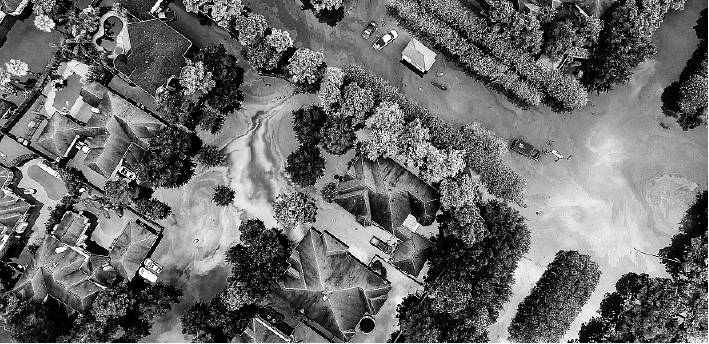Harvey flood victims get day in court
Residents and business owners say government responsible for damage
By Gabrielle Banks STAFF WRITER
Residents and business owners whose properties upstream of the Barker and Addicks reservoirs flooded after Hurricane Harvey argued Monday in Houston federal court that authorities knew for decades that the lakes likely would not be contained during a major flooding event and did nothing to prevent it, resulting in property damage for which owners should now be compensated.
The case in the U.S. Court of Federal Claims focuses on 13 test-case properties, agreed upon by the parties, that were surrounded by rising waters in the wake of the catastrophic 2017 storm. The first batch of lawsuits to go to trial involves the upstream properties, which were severely flooded as water built up in two “flood pools” west of Houston.
Hundreds have sued the federal government for damages, and other property owners may reap the benefits should the court find the federal government liable. The Army Corps of Engineers maintains the dams.
“People lost everything. People lost possessions, memories,” said Daniel Charest, an attorney for the residents and business owners, as he clicked through a slideshow of people fleeing their homes in makeshift rafts.
William Shapiro, a Justice Department attorney, countered that Harvey, which dumped up to 51 inches of rain on parts of the Houston region, was a “historically large rainfall event.” Between the two reservoirs, Shapiro said, this was a 770-year to 840-year flood event.
“Flooding in a storm of this size was inevitable,” said Shapiro, representing the Army Corps. “Dam failure would have risked hundreds of thousands of homes and structures and hundreds and thousands of lives.”
Properties downstream also were flooded after officials released water amid concerns that the dams could fail. Downstream flood damage is the subject of another batch of federal lawsuits yet to go to trial.
Harvey made landfall Aug. 25, 2017, before moving inland and soaking the Houston area with heavy rain. Nearly 80 people across Texas died during the storm, which caused an estimated $125 billion in damage in the Lone Star State.
The upstream trial before Sen. U.S. Judge Charles F. Lettow is set to last two weeks and will include a visit to the reservoirs and test properties by the federal judge, lawyers and experts.
The Addicks and Barker reservoirs, west of the Houston, were designed more than a half-century ago to prevent worst-case flooding during a massive rainfall. In the years after the reservoirs were built, Harris County and the city of Houston approved the construction of 30,000 suburban homes and businesses in Katy and west Houston on the edges of the reservoirs, inside invisible lake beds that government and private engineers had predicted would be affected by an extreme storm. More than 9,000 structures in the area flooded during Harvey, records show.
A large group of property owners has sued the U.S. Army Corps of Engineers, contending that in allowing the reservoirs to spill into dozens of neighborhoods, the government knowingly seized the properties on a temporary basis for water storage without compensation. Many had no idea — until Harvey struck — that their homes were within the reservoirs’ footprint, in areas engineers call “flood pools.”
At least 4,000 houses, apartment buildings and businesses west of the Barker Reservoir were damaged during Harvey, according to preliminary estimates by county officials. In the hardest-hit neighborhoods, floodwaters rose more than 5 feet and did not recede for a week or more.
Dozens of property owners filled the courtroom gallery Monday, with the test-case plaintiffs seated in the front row.
After opening statements, the first day focused on testimony from an Army Corps division chief, who was questioned by a lawyer for the property owners for more than five hours.
Robert Charles Thomas III, of the Corps’ engineering and construction division, testified that the reservoirs were designed to store floodwaters and protect downstream areas from catastrophic flooding.
Armistead Easterby, an attorney for the property owners, asked Thomas technical questions focusing on evidence that Corps engineers knew they didn’t have enough land to store the amount of floodwater that would build up.
Shapiro, of the Justice Department, interrupted with objections about certain documents, some of which dated back to 1940, being entered as evidence.
Todd Banker, who lives behind the Barker reservoir in Kelliwood, said during a break in the hearing that after his home flooded, he and his wife spent savings to provide for their 10-year-old special-needs daughter.
“That’s where it’s really hit us,” Banker said.
The Associated Press contributed to this report. gabrielle.banks@chron.com

